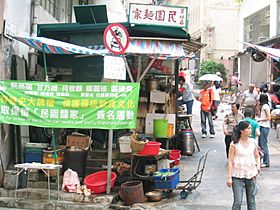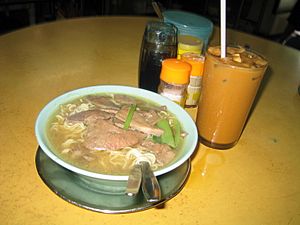Dai pai dong facts for kids
Quick facts for kids Dai pai dong |
|||||||||||
|---|---|---|---|---|---|---|---|---|---|---|---|

Man Yuen Noodles, a former dai pai dong on Elgin Street, Central. The Democratic Party banner calls for preservation of the stall.
|
|||||||||||
| Traditional Chinese | 大牌檔 | ||||||||||
| Simplified Chinese | 大牌档 | ||||||||||
| Literal meaning | Big Plate Stalls | ||||||||||
|
|||||||||||
| Cooked-food stalls | |||||||||||
| Traditional Chinese | 大排檔 | ||||||||||
| Simplified Chinese | 大排|档 | ||||||||||
| Literal meaning | large-row stalls | ||||||||||
|
|||||||||||
Dai pai dong (simplified Chinese: 大牌档; traditional Chinese: 大牌檔; pinyin: dàpáidàng) are a special kind of outdoor food stall. The name comes from Hong Kong, but people use it in other places too. The government officially calls them "cooked-food stalls."
The name dai pai dong means "big license stall" in Cantonese. This is because the licenses these stalls got were much bigger than those given to other street vendors.
These stalls first appeared after World War II in 1945. You can find them next to buildings, on streets, and in small alleys. For example, some in Central and Western districts are called "terrace type" because they are on sloped streets.
In the late 1900s, the Hong Kong government wanted to limit dai pai dong to clear public streets. Some stalls were moved indoors into special food markets built by the government. Since the 1970s, most dai pai dong are no longer run by families. Instead, they are owned by one person or a small group.
Today, only about 25 dai pai dong are left in Hong Kong. They are an important part of Hong Kong's history and culture. The word dai pai dong was even added to the Oxford English Dictionary in 2016.
Contents
What Makes a Dai Pai Dong Special?
A dai pai dong is easy to spot by its green-painted steel kitchen. They often have a busy, lively feel and do not have air conditioning. They are famous for serving tasty, low-priced dishes cooked quickly in a large wok.
Many people in Hong Kong see dai pai dong as a part of their shared memories. There are only 28 official dai pai dong left. Most are in Central (10), Sham Shui Po (14), Wan Chai (1), Tai Hang (2), and Tai O (1).
The term dai pai dong is sometimes used for any roadside food stall with foldable tables and chairs. However, legally, it only refers to the 28 stalls that have the special "big licenses."
A Look Back: History of Dai Pai Dong
Unlicensed food stalls started appearing in Hong Kong in the late 1800s. They sold cheap, everyday food like congee, rice, and noodles. These stalls helped people with lower incomes get affordable meals.
You could find these stalls in Central, Wan Chai, and near the Happy Valley Racecourse. In fact, a fire at the racecourse in 1918 was caused by food stalls set up nearby. There were also stalls near ferry piers, called Waisik Matau (meaning "Gluttonous Pier"), which served ferry passengers.
After World War II ended in 1945, the Hong Kong government gave out special licenses. These were for families of government workers who had died or been hurt in the war. This allowed them to run food stalls and earn a living. These licenses were much bigger than normal ones because they had to include a photo of the owner. People jokingly called them "dai pai" or "big license." Soon, these "big license stalls" became very popular on busy streets all over Hong Kong.
However, dai pai dong soon caused problems like traffic jams and hygiene issues. Some license holders even rented out their stalls illegally. Because of this, the government stopped giving out new "big licenses" in 1956. They also made it harder to transfer licenses. Licenses could no longer be passed down to children. They could only go to a spouse if the owner died. If there was no spouse, the license would simply end.
Since 1975, many dai pai dong have been moved into temporary markets. Examples include those on Haiphong Road in Tsim Sha Tsui. Others moved into cooked food centers, which are usually in buildings managed by the Urban Council. This made them easier to control.
To improve public hygiene, the government started buying back "big licenses" from owners in 1983. Many owners were older, and their licenses could only go to their spouses. So, many were happy to give up their licenses for money. This led to a fast decline in the number of traditional dai pai dong.
Today, most dai pai dong operate inside cooked food centers. Some successful ones have even become air-conditioned restaurants. However, some of these still keep their original outdoor stalls open, like Lan Fong Yuen (蘭芳園) on Gage Street in Central.
In 2003, when Hong Kong faced the SARS outbreak, dai pai dong became very popular. People thought air-conditioned places might spread the virus. So, they preferred to eat at open-air stalls instead.
What Can You Find at a Dai Pai Dong?
- You can often ask for changes to your dishes, like making them less spicy.
- Hong Kong local dishes are usually served in large portions. They are cheap and tasty.
- It is common to share tables with other people if there are not enough seats.
- Some dai pai dong might have old tables and stools. The floors can sometimes be a bit slippery.
- Dai pai dong are often set up with four canvas stands. Adding a cover helps protect diners from things falling.
- Many dishes are cooked very quickly in a wok over a big flame. Chefs use stir-frying to mix flavors fast.
- Unlike cha chaan teng (another type of Hong Kong eatery), most dai pai dong do not offer set meals.
- You can sometimes order food from a different stall. For example, if you are eating noodles at one stall, you might order milk tea from a stall a few steps away.
- Stalls usually operate either during the day or at night. Nighttime dai pai dong often sell seafood and more expensive dishes. These dishes usually cost around HKD$40–70.
- Daytime dai pai dong offer cheaper food, including:
- Congee and youtiao (fried dough sticks).
- Milk tea, toast, sandwiches, and instant noodles. These noodles often come with ham, egg, luncheon meat, or sausage.
- Rice or noodles with siu mei (燒味 roasted meats).
- Fried rice and dip tau fan (碟頭飯 rice plates).
- Chiuchow-style noodles.
Saving Dai Pai Dong
In May 2005, people became very concerned about dai pai dong. Man Yuen Noodles, a famous noodle stall in Central, was about to close. This was because the owner had died, and the license could not be passed on easily. This news came after a popular bakery known for its egg tarts also closed due to rising rent.
Many locals, including some politicians, asked for the stall to be saved. However, it closed on July 30, 2005. The Hong Kong government was criticized for not doing enough to protect dai pai dong as part of Hong Kong culture. The news of the closure happened at the same time the government was planning a new cultural district. Luckily, the bakery reopened in October 2005. The noodle stall also unexpectedly reopened in a nearby shop on December 1, 2005.
See also
 In Spanish: Dai pai dong para niños
In Spanish: Dai pai dong para niños



